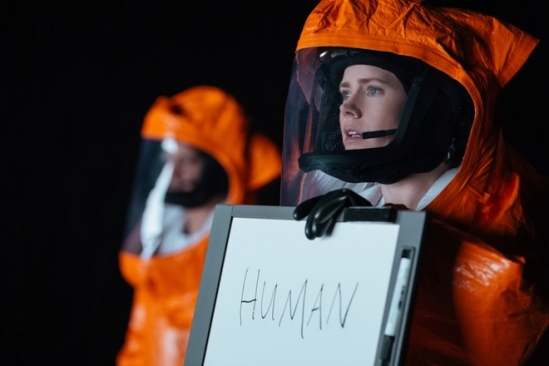
“Arrival” is the best sci-fi movie of the year, not just for the terrific performances by Amy Adams and Jeremy Renner, but because it’s rooted in the science part of science-fiction.
Adams plays Louise, a linguist and university professor whose services are called upon by Army Colonel Weber (Forest Whitaker) after egg-shaped alien vessels — referred to as “shells” — appear over 12 places on Earth. There’s one in Montana, another in China, a third over Russia — there’s even one hovering over the Indian Ocean, where I assume the aliens have joined the search for Malaysian Airlines Flight 370. I’m glad they didn’t appear over heavily populated cities, as in so many other alien-attack movies, so we don’t get the inevitable traffic jam shot and the cab flipping up in the air in an explosion.
In fact, “Arrival” isn’t about explosions and attacks with the military facing off against the aliens in a special effects battle a la “Independence Day.” It’s more about human curiosity and the scientists tasked with figuring out what the aliens want. To achieve that, Louise is teamed with theoretical physicist Ian (Jeremy Renner) to figure out a way to communicate with the aliens and determine why they’ve come to Earth. Louise and Ian are simultaneously exhilarated and wary, thrilled at the prospect of discovery, but not sure if their lives are in danger. Still, they agree, but demand to get as close as possible to the shells — and the aliens inside.
Director Denis Villeneuve, who made “Prisoners” (which I loved) and “Sicario” (which I didn’t), helps us understand where the science leads while keeping the relationships (between Louise and Ian, and with the aliens) uppermost in his storytelling. There’s a wonderful scene when the scientists, accompanied by some military personnel, get to go inside the shell to interact with the aliens, and Renner’s face silently shows his sense of wonder as he reaches his gloved hand out to touch the exterior of this alien vessel. Beautiful.
I’m also glad that Villeneuve didn’t design the aliens to look like us. From “The Day The Earth Stood Still” to “Close Encounters Of The Third Kind” to “ET,” to name just three examples, movie aliens are always bipeds with long arms and large almond-shaped eyes. Even the crazy people who claim to have been snatched and dragged off to a UFO claim their alien abductors look remarkably like humans. This, despite the fact that there are thousands of other lifeforms on our own planet that look nothing like us. Ever seen a tree? A jellyfish? A duck? What makes us think beings from elsewhere in the universe would have evolved into the same shapes as us?
I won’t spoil much more about the plot, but will admit that it took me awhile to figure out the ending, which is almost as confusing as the final 15 minutes of “2001.” I’ll just say that you shouldn’t assume that aliens necessarily live by the same rules we do when it comes to gravity, time, and other concepts.
I wonder if others who see “Arrival” will be as confused as I was when walking out of the theater, and if that will hurt word of mouth. That would be a shame, because it got off to a good start at the box office, according to Vulture:
In its first weekend, Arrival earned $24 million, good for third place behind Doctor Strange and Trolls, each of which held their positions from last week. Making that number even more impressive is the fact that Arrival debuted in just 2,317 locations, or about 60 percent of the theaters that Doctor Strange played in last week; its $10,358 per-theater average is the highest of any live-action wide release this year that isn’t part a pre-existing franchise. (Are there any others, you might ask? A few!)
As Mark Harris pointed out in The Ringer’s state-of-Hollywood essay, there seems room for a smart space movie every fall, with Arrival following in the proud tradition of Gravity (2013), Interstellar (2014), and The Martian (2015). Arrival couldn’t replicate the openings of those films, all of which were huge hits, but at a $47 million budget, it also cost less than half of any them.
Even with my confusion at the ending — which has been cleared up by my friend Tom O’Toole in a genuine “Aha!” moment — I still enjoyed “Arrival” very much. It’s especially satisfying to see a science-fiction movie that’s wholly original and doesn’t sacrifice or cheapen the science for the sake of the fiction.
On my KTRS show Friday, I originally gave “Arrival” a 7.5 out of 10, but after thinking about it some more and discussing it with others who have seen it, my admiration has grown, so I’m now giving it an 8.5.
